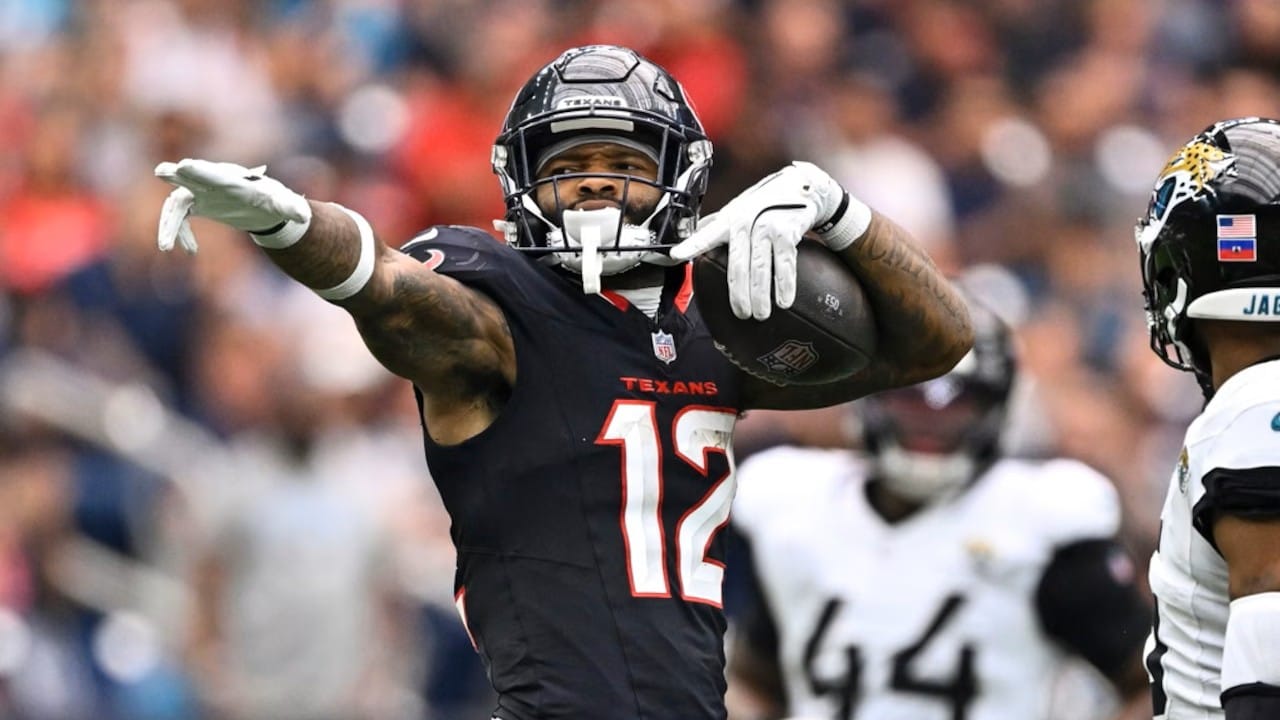
Quick Slant: TNF - The Football Gods are Nihilists
Mat Irby’s Quick Slant
Sports lie in this fuzzy penumbra between the brutality, discipline, and operational calculus of a military campaign, and something as cold and unfeeling as a dice roll; it is clear which the public ignores, and which it identifies as cause.
It is romantic to hang the themes of storybooks and legends on the will of man. It helps us feel in control to credit preparedness, brilliance, work ethic, and the inevitable dominance of raw physicality to our victors. We define champions by how badly they wanted it, and runners-up are explained as incapable of meeting the moment.
But what we deny is that sports are statistical games, and statistics invite variance.
Dan Marino dominated a generation of QBs, dragging inferior rosters to deep playoff runs each season; yet he couldn’t win the big one. Charles Barkley, Karl Malone, and Patrick Ewing posted undeniable Hall of Fame credentials, but their empty fingers mark them like scarlet letters. Barry Bonds, Dominik Hasek, Lee Westwood, Ernie Banks, Fran Tarkenton, Roberto Baggio, Cowboy Cerrone, Eric Lindros, and Ted Williams—in the end, all "chokers."
As ruthless sports fans, we demand that somebody fall on the sword; this drives an entire cottage industry: sports panel shows that reduce whole careers to ashes based on vapid, emotional overreactions to what happened yesterday. There is something cathartic about grown adults yelling at each other—at least one of whom screams our feelings as if it’s their most deeply held conviction. Alas, in the end, these are swindlers, using your feelings as leverage to steal a small investment of your time—their opinions, overblown distractions lacking substance, designed to keep you tuning in.
Careers span a handful of years, yielding incredibly small datasets; even the longest—20 to 25 years—would never be credible sample sizes for stable math. It’s not satisfying, but it’s true: it may be that Marino didn’t win because one team had to lose; meanwhile, Terry Bradshaw has four rings with half the passing yardage, in large part due to playing alongside nearly four times the Hall of Famers. Justice, in sports, is rarely proportional.
The Bills and Texans enter Thursday Night with 12 wins between them. These are good records, not great ones. They make a specific impression. For Buffalo, beginning to compile a new regime of late-season failures and general disappointments, the narrative is obvious. But for Houston, there is no narrative, because nobody’s paying attention. And yet, the Texans have the best scoring defense, and they have allowed the least yardage (which is honestly not even close at this point).
Isn’t it possible that the Texans are more dangerous than people perceive them, and that the Bills are still the contenders we believed them to be to start the season? Isn’t it so that the Texans are a fourth-and-ten Baker Mayfield scramble, a Nate Landman “Peanut Punch” of Dare Ogunbowale, and a Wil Lutz 34-yard field goal away from a totally different narrative? Isn’t it true that one heroic Drake Maye drive is all that keeps Buffalo from entering Thursday with a shot at a share of the best record in football?
If so, then this is an excellent game disguised as a fine one—a fire smoldering beneath ash. And within it, whether we recognize it or not, the implications for the two teams involved are absolutely enormous. The Texans and Bills will do their due diligence and be prepared, but the football gods are nihilists—agents of chaos, even—and they shake their dice cup before sinister smirks, just out of focus, and whisper it to each other:
This is gonna be fun.
Bills
Implied Team Totals: 24.5
The Bills entered the season as one of the heavier Super Bowl favorites; today, they should still be viewed as outside contenders with a puncher’s chance. They rank ninth in Pythagorean expected wins.
Meanwhile, the Texans, from whom nobody seems to expect anything—owners of the league’s best defense—are slightly better in Pythagorean expected wins at seventh, pacing for a half a win more.

The Bills have had an excellent offense, as we’d expect, but their defense shows cracks that it typically hasn’t under HC Sean McDermott; they rank slightly below average in defensive efficiency and well above average in offensive efficiency. This is the sweet spot for fantasy production because it drives scoring, increases volume, and results in more TDs.

Buffalo ranks second in offensive EPA per play and fourth in offensive success rate.

They rank third in offensive EPA per dropback and sixth in offensive success rate on dropbacks.
The Bills pass at a rate of 48% (T-29th), and they are slow at the line (28.7 seconds to snap, T-30th). They remain run-heavy when they dictate the terms, although not quite as dramatically; their pass rate over expected (PROE) is -0.87% (20th).
They spend 27.6% of plays from a lead of seven or more (5th); from this, they drop to a 42% pass rate, so they spend a lot of extra time in an even heavier run script.
Their play volume is middle-of-the-pack at 64 offensive plays per 60 minutes (T-15th). Josh Allen has just 34.7 dropbacks per game (23rd), converting those into 29.3 attempts per game (25th). He makes the most of his modest opportunity; Allen earns 0.75 fantasy points per dropback (1st).
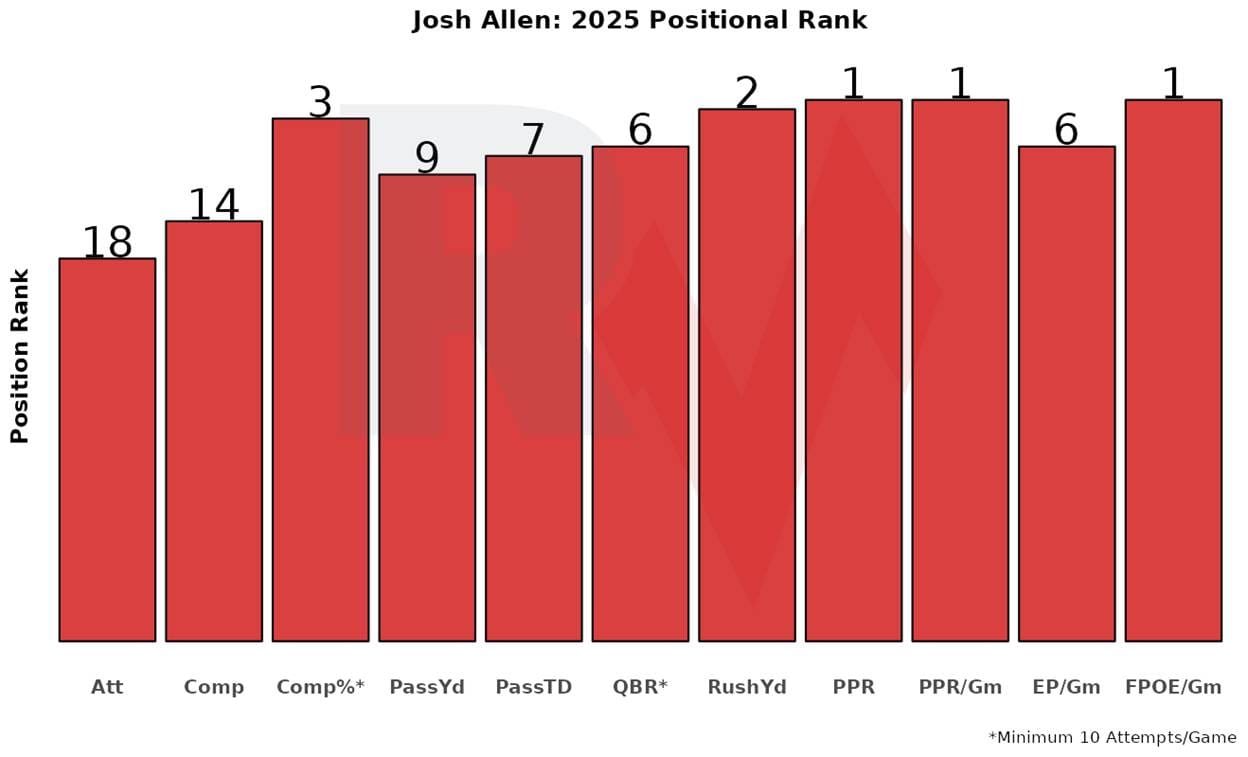
A big part of Allen’s overall efficiency stems from his rushing production; yet again, Allen provides a massive rushing platform. He is second in QB rushing (351) and first in QB rushing TDs (10). He leads the NFL in QB rush attempts inside the five (13).
But, of course, what differentiates Allen (and few others) is that he is also a tremendous passer. Even with low opportunity, he ranks ninth in passing yards (2,456) and seventh in passing TDs (T-18). He ranks fourth in EPA + CPOE composite.
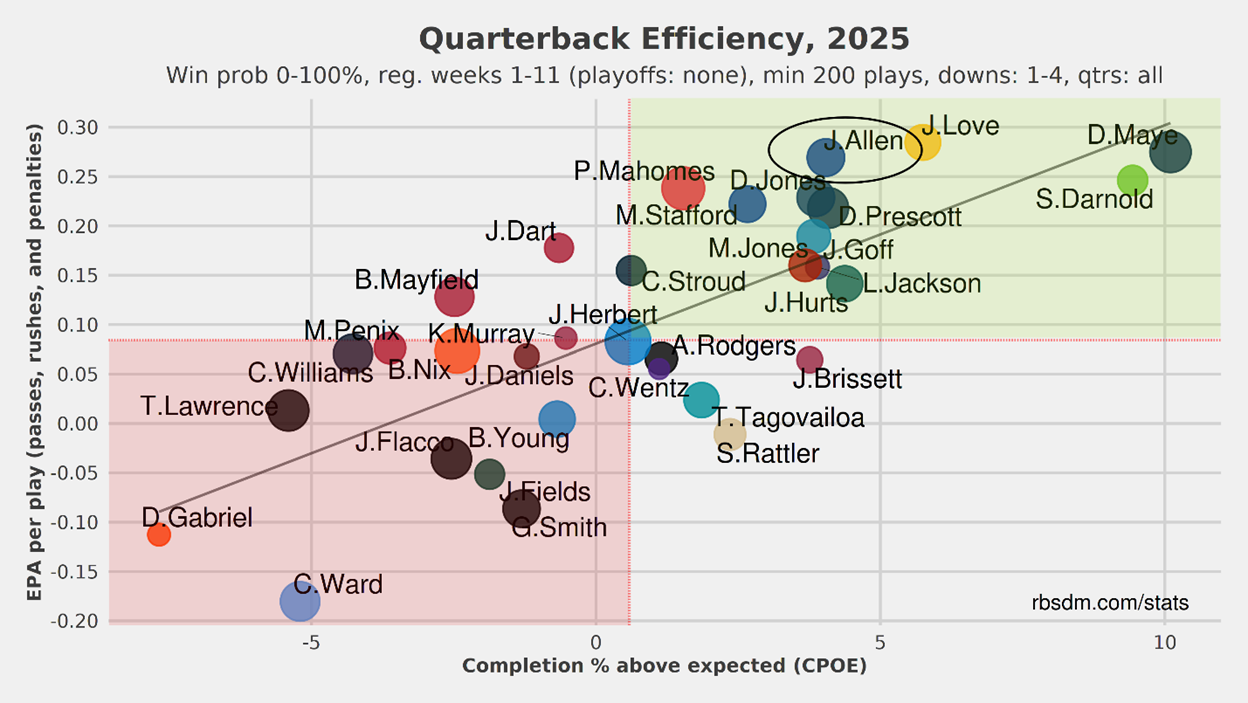
Allen is, of course, one of the most consistently high-level entities in fantasy football. He has been a QB1 in all but two weeks, and only once has he borderline tanked a single-QB lineup. And his highs are massive, as we saw a week ago, during a six-TD (3 rushing, 3 passing) performance that put him right back in the MVP discussion.
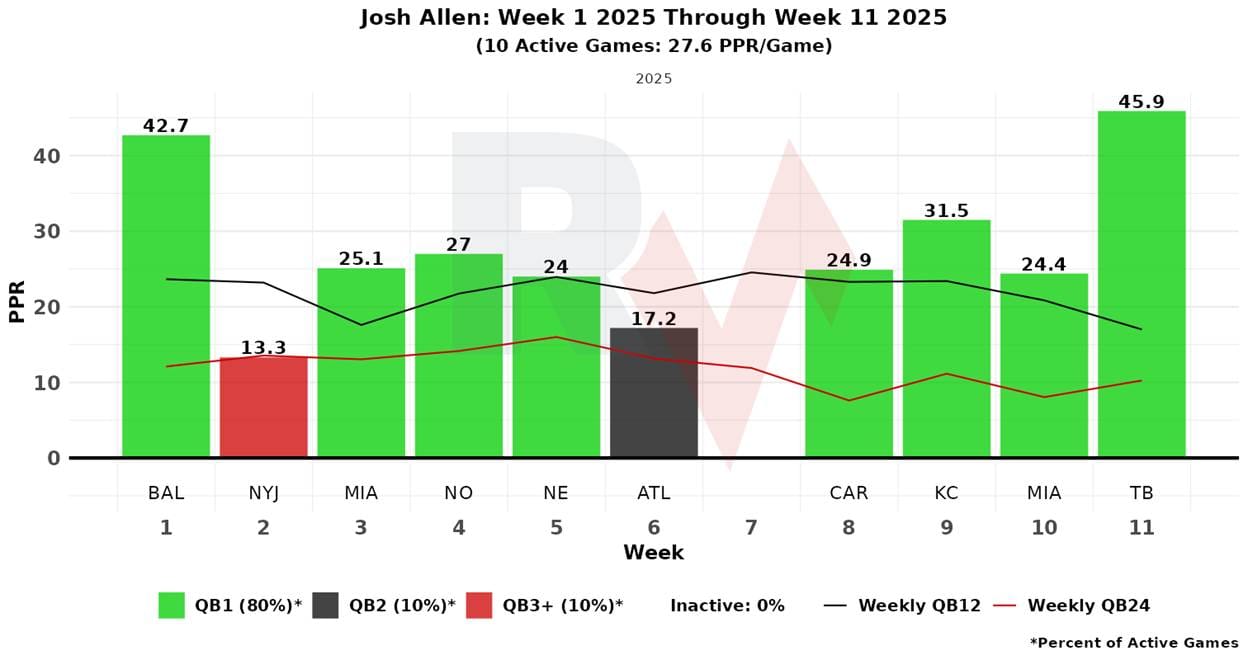
As we will see repeatedly, the Texans have a great defense, especially against the passing game. In their last five games, the Texans have allowed the 22nd most fantasy points to QBs. The Texans have been especially vulnerable to rushing QBs during that time; they’ve surrendered the fifth-most rushing yards to QBs.
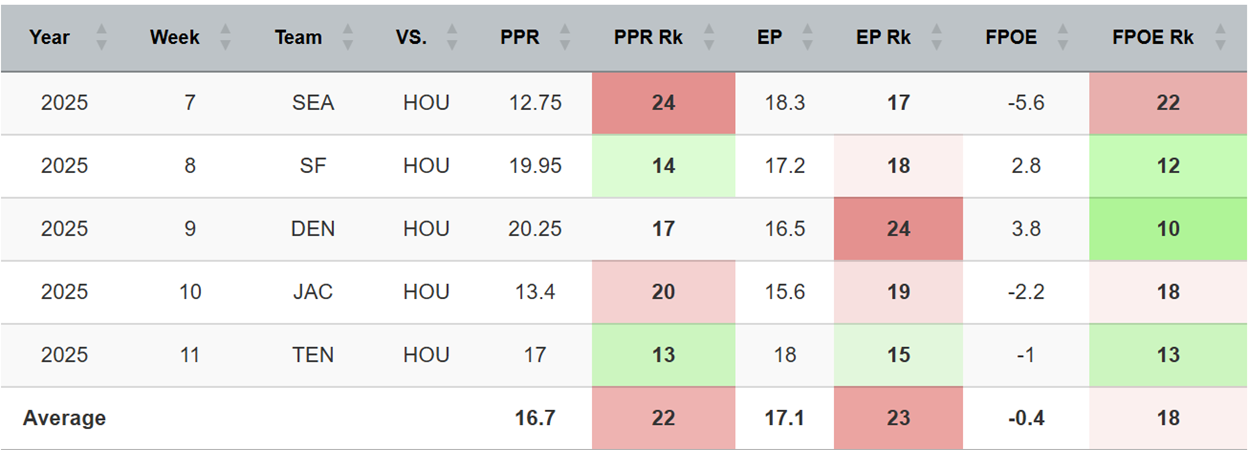
The Bills have a very broad target distribution; only one pass-catcher has a target share per game above 15%: Khalil Shakir (22.1%). TE Dalton Kincaid is expected to miss the game with an injury, and WR Keon Coleman, who was a DNP (coach’s decision) in Week 11, is expected to ride the bench again. He is shaping up as a 2024 second-round draft bust.

Even with Shakir dominating his team’s targets, a 22% share is not exceptional. In an offense with few passing attempts to go around, a 22% share is especially shaky.
Shakir continues to be a bit of a Great Value Deebo Samuel type—low aDOT (4.4, 94th), big YAC (362, 2nd). In fact, Shakir ranks near the top in YAC, but he ranks dead last among qualified receivers in aDOT.
Shakir is pretty mid in terms of efficiency, compiling 30.17 EPA (49th) and 1.71 yards per route run (YPRR, T-37th). In the end, without maximal efficiency, he can’t keep up with better low aDOT/high YAC types (Rashee Rice, Jameson Williams). And yet, he's not quite that very high-floor/very low-ceiling Welkery/Landryish PPR accumulator-type either (Ladd McConkey).
Shakir has been a WR1 only once, but is generally usable, with the caveat that he lacks consistent upside. This is not my preferred archetype, but if you’ve got him, it is what it is, and you’re probably using him.

The Texans are also good against WRs; opposing WRs have ranked 26th against them in their last five games. The Texans have generally had teams try to win through the air, which explains the higher expected points (EP), but they’ve rarely succeeded, which explains the lower fantasy points over expected (FPOE).

With Coleman being demoted, we saw WRs Josh Palmer, Tyrell Shavers, and Gabe Davis all earn at least four targets last week. Against such a killer pass defense in a game with an over/under of just 43.5, it seems like a bad week to try to use any receiver other than Shakir in most scenarios.
With Kincaid out last week, Dawson Knox slid into a 78% snap share. He’s almost the TE equivalent of a handcuff, but again, the lower volume is limiting. And the Texans have also been a tough nut to crack for the TE position as well. Opposing TEs have ranked 25th in fantasy scoring against Houston in their last five. Summoning Knox as a streamer is also a hard ask this week.
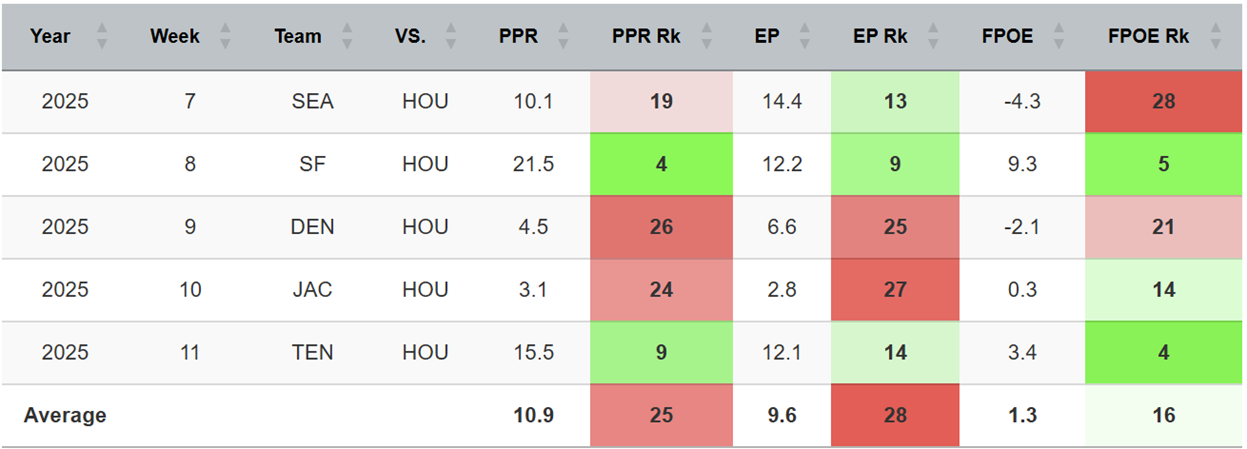
The Texans rank third in EPA per play allowed and third in defensive success rate.

They rank first in EPA per dropback allowed and second in defensive success rate.
The Texans use a wide-9 scheme and use zone at a rate of 77.8% (5th), with an even mix of single-high (48.6%) and shell (51.4%). Their preferred alignments are Cover 3 (30.9%) and Cover 4 (23.3%). They blitz at the below-average rate of 23%.
Fantasy Points’ coverage matchup tool assigns a zero-based matchup grade to each pass-catcher based on their opponent’s use of specific types and rates of coverage and how that pass-catcher performs against them. Positive numbers indicate a favorable matchup and negative numbers indicate an unfavorable one.
Based on this criterion alone, the Bills’ pass-catcher with the best assignment is Knox (+15.3%). Shakir has a slightly favorable matchup (+1.7%), and no other pass-catcher qualifies for the tool.
PFF’s matchup tool is player-based, pitting the PFF ratings of individual players against each other for an expected number of plays based on historical tendencies and rating on a scale from great to poor.
Based on the player-specific model, Shakir’s matchup grades out as good, while Allen’s, Shavers’, and Knox’s grade out as poor.
Buffalo’s offensive pass-blocking allows a 5.8% pressure rate over expected (PrROE, 14th of 28 Week 12 teams) to opposing defenses; Houston generates a 10.9% PrROE (5th) as a defense; the composite of each team’s PrROE results in a pretty neutral matchup.
Buffalo’s run-blocking unit averages 2.17 adjusted yards before contact per attempt (Adj. YBC/Att, 5th of 28 Week 12 teams), and the Texans allow 2.51 Adj. YBC/Att (T-24th of 28 Week 12 teams). This gives the Bills the third most-significant run-blocking advantage of the week.
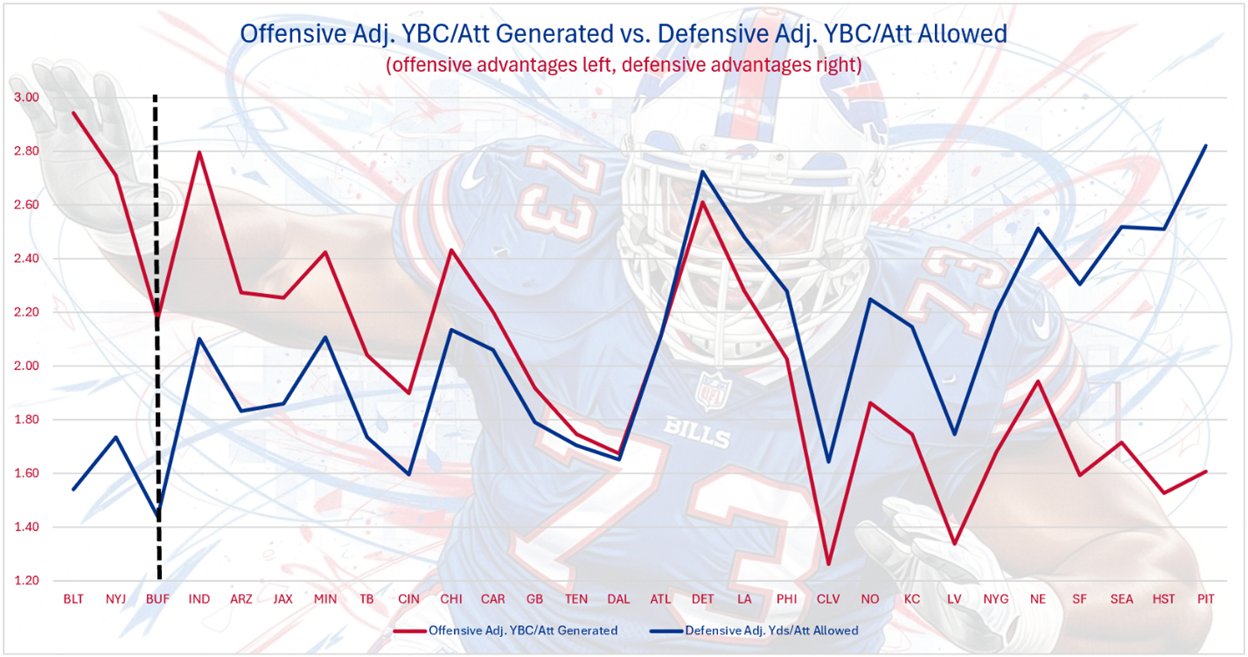
The Bills rank fourth in offensive EPA per rush and sixth in offensive success rate on rushes. The Texans rank ninth in EPA per rush allowed and 13th in defensive success rate on rushes.
RB James Cook is the Bills’ lead back, earning 60% of the team’s rush attempts. The Bills use RBs Ty Johnson and Ray Davis, but they do so sparingly: each has no more than 8% of the team’s rush attempts or 4% of the team’s targets.

Cook earns borderline elite opportunity in the run game, but his lack of substantial involvement in the passing game keeps him from hitting the upper echelon. Even with good TD production, which he’s maintained for almost two full years now, Cook is unable to be a part of the high-high upside tier at RB.
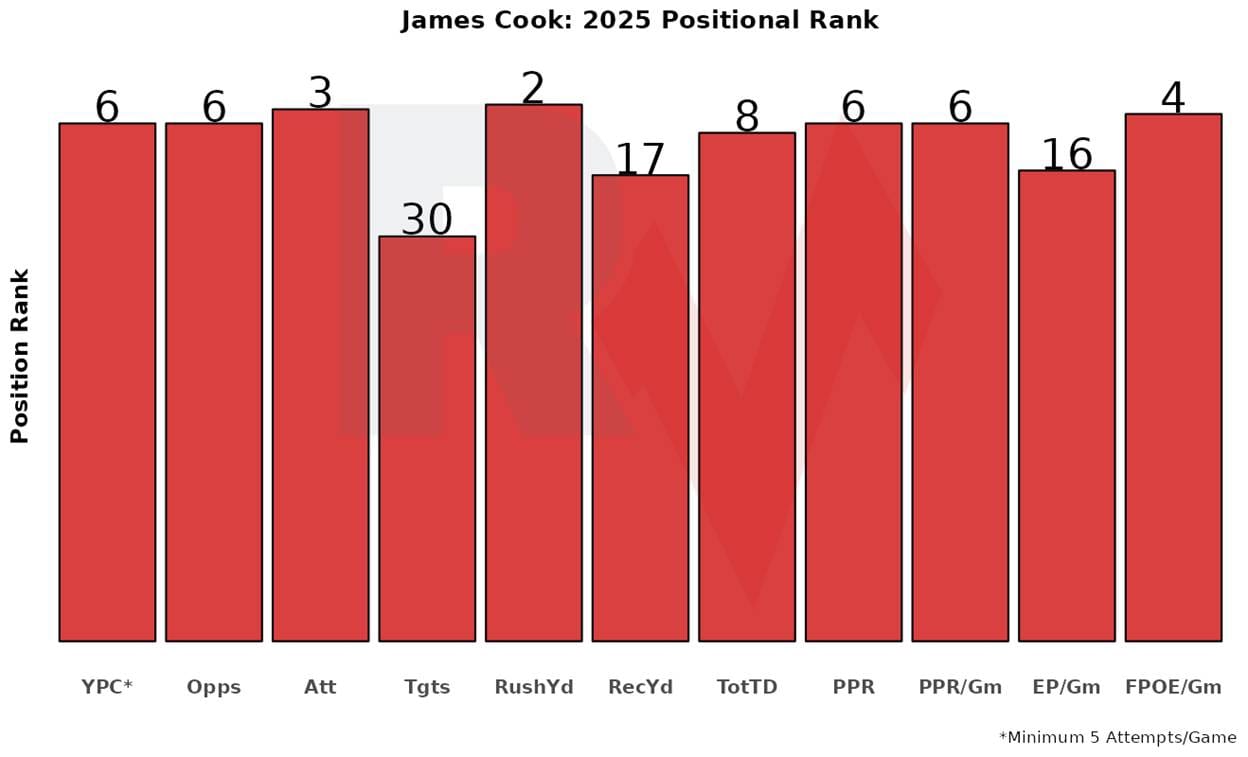
Cook is in the next tier down, but he has been an RB1 in six of the ten weeks. He has only really taken a nosedive once, and that was in a game where the team almost inexplicably abandoned the run. He's an auto-start everywhere.
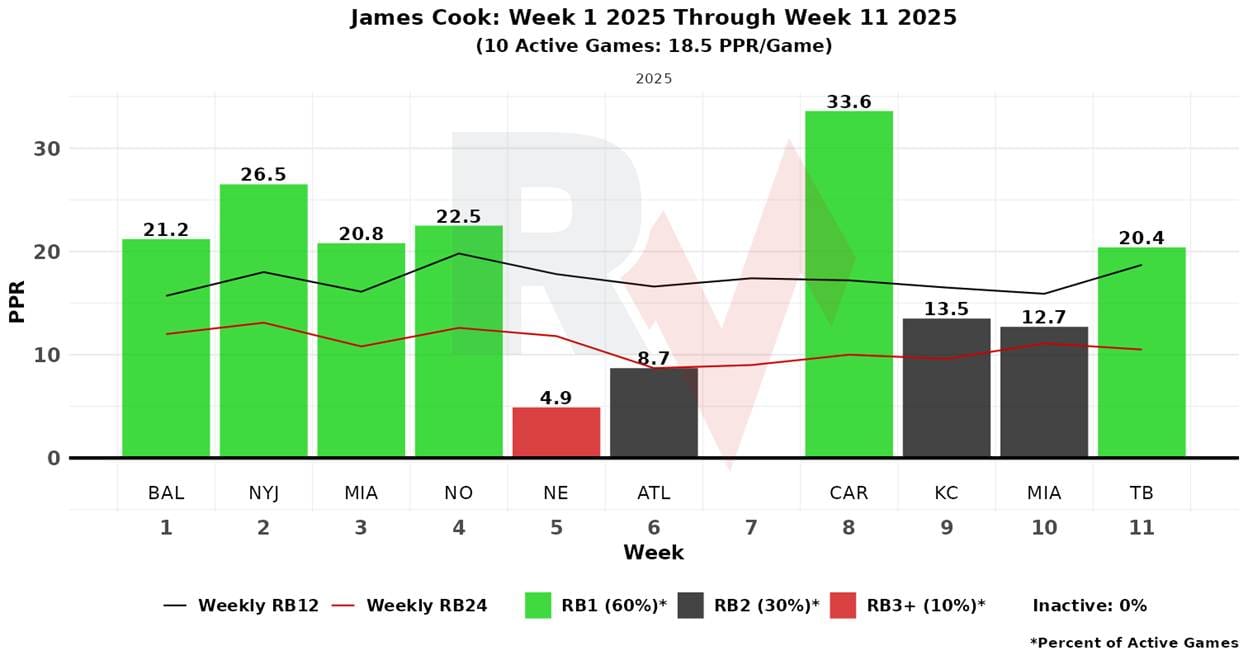
The Texans are, yet again, good at stopping fantasy RBs in their last five games. Opposing RBs rank 22nd during that span. During that span, they’ve faced Christian McCaffrey, but not a lot of big-time heavy-hitters.
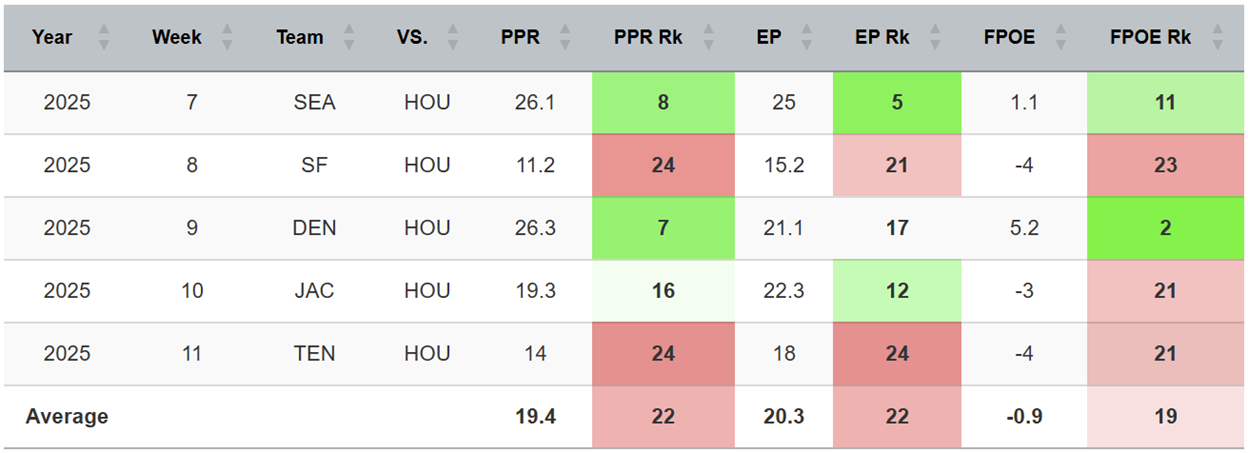
Based on the season-long EPA numbers, the chink in the armor for Houston is their run defense, even if they’ve done better of late. Since the Bills are usually predisposed to the run, Cook feels like a good bet to run the ball frequently.
